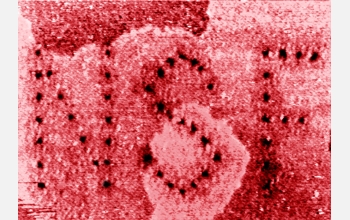News Release 05-144
Researchers Carve with Electricity at the Nanometer Scale
Process may yield miniscule molecular detection devices, semiconducting connectors and molecular sieves
August 17, 2005
This material is available primarily for archival purposes. Telephone numbers or other contact information may be out of date; please see current contact information at media contacts.
By applying electric current through a thin film of oil molecules, engineers have developed a new method to precisely carve arrays of tiny holes only 10 nanometers wide into sheets of gold. The new system, called Electric Pen Lithography (EPL), uses a scanning-tunneling microscope, fitted with a tip sharpened to the size of a single atom, to deliver the charge through the dielectric oil to the target surface.
With EPL, the researchers can both see and manipulate their target at the same time, all without the constraints of the vacuum chamber required by similar processes. With such tight control, the researchers hope the relatively inexpensive procedure will have applications for crafting single DNA detection devices such as nanopores, nanoscale interconnects in biological and semiconducting devices, molecular sieves for protein sorting and nanojets for fuel or drug delivery.
Mechanical engineer Ajay Malshe of the University of Arkansas, his students Kumar Virwani and Devesh Deshpande, and Kamalakar Rajurkar of the University of Nebraska, Lincoln will present the new innovation at the International Institution for Production Engineering Research General Assembly in Antalya, Turkey, Aug. 21-27.
For additional information, see the University of Arkansas release at:
Oil Worth Its Weight in Gold in Directed Nanomachining
http://dailyheadlines.uark.edu/4822.htm
This research was supported by NSF Grant #0423698
Collaborative Research: Development Of Nano-Electrical Discharge Machining (NANO-EDM) For Advanced Manufacturing
http://www.nsf.gov/awardsearch/showAward.do?AwardNumber=0423698
-NSF-
Media Contacts
Joshua A. Chamot, NSF, (703) 292-7730, email: jchamot@nsf.gov
Melissa Blouin, University of Arkansas, (479) 575-3033, email: blouin@uark.edu
Program Contacts
Kevin W. Lyons, NSF, (703) 292-5365, email: klyons@nsf.gov
Principal Investigators
Ajay P. Malshe, University of Arkansas, (479) 575-6561, email: apm2@engr.uark.edu
Kamlakar P. Rajurkar, University of Nebraska-Lincoln, (402) 472-1385, email: krajurka@unlnotes.unl.edu
Related Websites
Ajay Malshe homepage: http://mrl.engr.uark.edu/
The U.S. National Science Foundation propels the nation forward by advancing fundamental research in all fields of science and engineering. NSF supports research and people by providing facilities, instruments and funding to support their ingenuity and sustain the U.S. as a global leader in research and innovation. With a fiscal year 2023 budget of $9.5 billion, NSF funds reach all 50 states through grants to nearly 2,000 colleges, universities and institutions. Each year, NSF receives more than 40,000 competitive proposals and makes about 11,000 new awards. Those awards include support for cooperative research with industry, Arctic and Antarctic research and operations, and U.S. participation in international scientific efforts.
Connect with us online
NSF website: nsf.gov
NSF News: nsf.gov/news
For News Media: nsf.gov/news/newsroom
Statistics: nsf.gov/statistics/
Awards database: nsf.gov/awardsearch/
Follow us on social
Twitter: twitter.com/NSF
Facebook: facebook.com/US.NSF
Instagram: instagram.com/nsfgov

